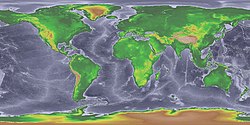Beringia
The Bering land bridge joined present-day Alaska and eastern Siberia at times during the Pleistocene ice ages.
Its greatest extension was about 1,000 miles (1,600 km) north to south. It was not glaciated because snowfall was extremely light as the winds from the Pacific Ocean lost their moisture over the fully glaciated nearby mountains.
The grassland steppe, including the land bridge, that stretched for several hundred miles into the continents on either side has been called Beringia. It is believed that a small human population of at most a few thousand survived the ice age in Beringia. It was isolated from populations in Asia for at least 5,000 years. Sometime after 16,500 years ago, it started to populate the Americas when the American glaciers that blocked the way southward melted.[1][2][3][4]
Geography
The Bering Strait, the Chukchi Sea to the north and the Bering Sea to the south, are all shallow seas (maps, right). During cycles of global cooling, such as the most recent ice age, much water became concentrated in the ice caps of the Arctic and Antarctica. The drop in sea levels exposed shallow sea floors that have subsequently re-flooded. Other land bridges around the world have been created and re-flooded in the same way: about 14,000 years ago, mainland Australia was linked to both New Guinea and Tasmania. The British Isles were an extension of continental Europe via the dry bed of the English Channel; and the dry basin of the South China Sea linked Sumatra, Java and Borneo to the Asian mainland.
The rise and fall of global sea levels exposed and submerged the bridging land mass called "Beringia" several times in the Pleistocene. The Beringian land bridge is believed to have existed in the glaciation that occurred before 35,000 BP. During the more recent period 22,000-7,000 years BP it was also above water. The strait reopened about 15,500 BP[5] and by c. 6000 BP the coastlines had their present form.[6]
Human habitation
The Beringa land bridge is significant for several reasons, not least because it is believed to have enabled human migration to the Americas from Asia about 25,000 years ago.[7] A study by Hey[8] has indicated that of the people migrating across this land bridge during that time period, only 70 left their genetic print in modern descendants.
Further reading
- Pielou E. C. 1992. After the Ice Age : the return of life to glaciated North America (Chicago: University of Chicago Press)
- Hey, Jody 2005. On the number of New World founders: a population genetic portrait of the peopling of the Americas. In Public Library of Science Biology. 24;3(6):e193
Beringia Media
The Mammut americanum (American mastodon) became extinct around 12,000–9,000 years ago due to human-related activities, climate change, or a combination of both. See Quaternary extinction event and Holocene extinction.
Map showing the approximate location of the ice-free corridor along the Continental Divide, separating the Cordilleran and Laurentide ice sheets. Also indicated are the locations of the Clovis and Folsom Paleo-Indian sites.
Map shows the connection between North America and Asia during the Late Cretaceous period (~80Ma).
References
- ↑ Goebel, Ted; et al. (2008). "The late Pleistocene dispersal of modern humans in the Americas". Science. 319 (5869): 1497–1502. doi:10.1126/science.1153569. PMID 18339930. S2CID 36149744.
- ↑ Fagundes, Nelson J.R.; et al. (2008). "Mitochondrial population genomics supports a single pre-Clovis origin with a coastal route for the peopling of the Americas". American Journal of Human Genetics. 82 (3): 583–592. doi:10.1016/j.ajhg.2007.11.013. PMC 2427228. PMID 18313026.
- ↑ Tamm, Erika; et al. (2007). "Beringian standstill and spread of native American founders". PLOS ONE. 2 (9): e829. doi:10.1371/journal.pone.0000829. PMC 1952074. PMID 17786201.
- ↑ Achilli A.; et al. (2008). "The phylogeny of the four Pan-American mtDNA haplogroups: implications for evolutionary and disease studies". PLOS ONE. 3 (3): e1764. doi:10.1371/journal.pone.0001764. PMC 2258150. PMID 18335039.
- ↑ E.C. Pielou 1991. After the Ice Age: the return of life to glaciated North America. Chicago: University of Chicago Press, p19 and note.
- ↑ Isostatic rebound has continued to raise some sections of coast (because the huge weight of the ice is lifted).
- ↑ "National Geographic. Atlas of the human journey. 2005". Archived from the original on 2008-04-05. Retrieved 2009-12-03.
- ↑ Hey, Jody (2005). "On the number of New World founders: a population genetic portrait of the peopling of the Americas". PLOS Biology. 3 (6): e193. doi:10.1371/journal.pbio.0030193. PMC 1131883. PMID 15898833.
Other websites
- Bering Land Bridge National Preserve
- Beringian Heritage International Park Program
- D.K. Jordan, "Prehistoric Beringia" Archived 2008-12-25 at the Wayback Machine
- Paleoenvironmental atlas of Beringia: includes animation showing the gradual disappearance of the Bering land bridge
- Yukon Beringia Interpretive Centre Archived 2009-01-24 at the Wayback Machine
- Paleoenvironments and Glaciation in Beringia Archived 2004-12-12 at the Wayback Machine
- Study suggests 20000 year hiatus in Beringia
- Mitochondrial Population Genomics Supports a Single Pre-Clovis Origin with a Coastal Route for the Peopling of the Americas Archived 2008-10-03 at the Wayback Machine, American Journal of Human Genetics, 82 (3), 583-592 (3 March 2008). pdf file of article (525kb)











